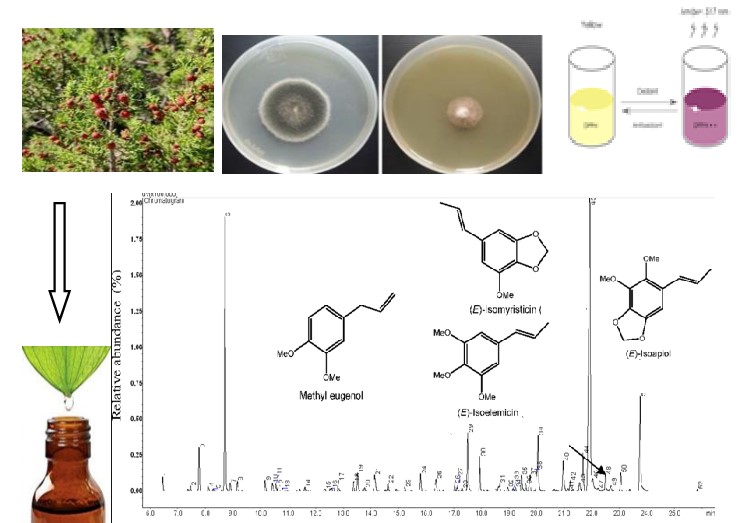Antimicrobial and Antioxidant activities of Algerian Juniperus phoenicea and Salvia officinalis Essential Oils
DOI:
https://doi.org/10.29356/jmcs.v67i2.1921Keywords:
Antibacterial, antifungal, antioxidant, essential oils, GC-MSAbstract
Abstract. In this work, the chemical composition, antioxidant and antifungal activities of Juniperus phoenicea and Salvia officinalis essential oils (Eos) were evaluated. The Gas Chromatography-Mass spectrometry (GC-MS) identification of S. officinalis Eo revealed the predominance of cis-chrysanthenyl acetate (64.82 %), and α- thujone (14.7 %). The main compounds of J. phoenicea oil were α-Pinene (64.4 %) and δ-3-Carene (7.02 %). The antibacterial activity was evaluated using the agar well diffusion method. The most susceptible bacteria was Staphylococcus aureus. The antifungal activity was tested against Aspergillus and Penicillium species by the poisoned food method. The two essential oils (Eos) exhibited an antifungal activity, with S. officinalis oil being the most potent one (8-82 % of inhibition). The antioxidant activity was characterized by the DPPH free radical scavenging method. J. phoenicea and S.officinalis Eos had both a moderate antioxidant effect. Additionally, an antagonistic effect was observed between the Eos when used in combination.
Resumen. En este trabajo se evaluó la composición química, actividad antioxidante y antifúngica de los aceites esenciales de Juniperus phoenicea y Salvia officinalis (Eos). La identificación por cromatografía de gases-espectrometría de masas (GC-MS) de los aceites de S. officinalis reveló el predominio del cis-crisantenil acetato (64.82%) y α-tujona (14.7%). Los principales compuestos del aceite de J. phoenicea fueron α-pineno (64.4%) y el δ-3-careno (7,02 %). La actividad antibacteriana se evaluó mediante el método de difusión en pozo de agar. La bacteria más susceptible fue Staphylococcus aureus. La actividad antifúngica se probó contra especies de Aspergillus y Penicillium por el método de alimentos envenenados. Los dos aceites esenciales exhibieron actividad antifúngica, siendo el aceite de S. officinalis el más potente (8-82% de inhibición). La actividad antioxidante se caracterizó por el método de captación de radicales libres DPPH. J. phoenicea y S.officinalis tuvieron un efecto antioxidante moderado. Además, se observó un efecto antagónico entre los Eos cuando se usaban en combinación.
Downloads
References
Bintsis, T. AIMS Microbiol. 2017, 3, 529-563. DOI: https://doi.org/10.3934/microbiol.2017.3.529
Alshannaq, A.; Yu, J.H. Int. J. Environ. Res. Public. Health. 2017, 14, 632. DOI: https://doi.org/10.3390/ijerph14060632
Mimica-Dukić, N.; Božin, B. Natural Product Communications. 2007, 2, 445-452. DOI: https://doi.org/10.1177/1934578X0700200416
Nicolopoulou-Stamati, P.; Maipas, S.; Kotampasi, C.; Stamatis, P.; Hens L. Front. Public Health. 2016, 4, 148. DOI: https://doi.org/0.3389/fpubh.2016.00148 DOI: https://doi.org/10.3389/fpubh.2016.00148
Orhan, I. E.; Tumen, I., in: The Mediterranean Diet. Preedy, V.R., Watson, R.R., Ed., Academic Press, London, 2015, 639-648. DOI: https://doi.org/10.1016/B978-0-12-407849-9.00057-9
Ramos da Silva, L.R.; Ferreira, O.O.; Cruz, J.N.; de Jesus Pereira Franco, C.; Oliveira dos Anjos, M. M.; Almeida da Costa, W.; Helena de Aguiar Andrade, E.; Santana de Oliv eira, M. Evid Based Complement Alternat. Med. 2021, 2021, 18. DOI: https://doi.org/10.1155/2021/6748052
Bakkali, F., Averbeck, S., Averbeck, D.; Waomar, M. Food Chem. Toxicol. 2008, 46, 446-475. DOI: https://doi.org/10.1016/j.fct.2007.09.106
Adams, R.P. Allured Publishing Corporation, Carol Stream, USA. 2007, 1-803.
Sahin, F.; Güllüce, M.; Daferera, D.; Sökmen, A.; Sökmen, M.; Polissiou, M.; Agar, G.; Özer, H. Food Control. 2004, 15, 549-557. DOI: https://doi.org/10.1016/j.foodcont.2003.08.009
Rodea-Palomares, I.; Petre, A.L.; Boltes, K.; Leganés, F.; Perdigón-Melón, J.A.; Rosal, R.; Fernández-Piñas, F. Water Res. 2010, 44, 427-438. DOI: https://doi.org/10.1016/j.watres.2009.07.026
Rhayour, K.; Bouchikhi, T.; Tantaoui-Elaraki, A.; Sendide, K.; Remmal, A. J. Essent. Oil Res. 2003, 15, 356-362. DOI : https://doi.org/10.1080/10412905.2003.9698611
Srivastava, S.; Singh, R.P. Indian Perfumer. 2001, 45, 49-51.
Shukla, R.; Kumar, A.; Singh, P.; Dubey, N.K. Int. J. Food Microbiol. 2009, 135, 165-170. DOI: https://doi.org/10.1016/j.ijfoodmicro.2009.08.002
Ghouti, D.; Lazouni, H.A.; Moussaoui, A.; Chabane Sari, D. Phytothérapie. 2018, 16, S74-S83. DOI: https://doi.org/10.3166/phyto-2018-0061
Medini, H.; Elaissi, A.; Larbi Khouja, M.; Piras, A.; Porcedda, S.; Falconieri, D.; Chemli, R. Nat. Prod. Res. 2011, 25, 1695-1706. DOI: https://doi.org/10.1080/14786419.2010.535168
Khalil, R.; Li, Z.G. Afr. J. Biotechnol. 2011, 10, 8397-8402. DOI: https://doi.org/10.5897/AJB10.2615
Khedher, M.R.B.; Khedher, S.B.; Chaieb, I.; Tounsi, S.; Hammami, M. EXCLI J. 2017, 16, 160-173. DOI: https://doi.org/10.17179/excli2016-832
Barra, A. Nat. Prod. Commun. 2009, 4, 1147-1154.
Sepahvand, R.; Bahram, D.; Saeed, G.; Marzieh, R.; Gholam Hassan, V.; Javad, G.Y. Asian Pac. J. Trop. Med. 2014, 7, S491-S496. DOI: https://doi.org/10.1016/S1995-7645(14)60280-7
Ruberto, G.; Baratta, M.T. Food Chem. 2000, 69, 167-174. DOI: http://dx.doi.org/10.1016/S0308-8146(99)00247-2 DOI: https://doi.org/10.1016/S0308-8146(99)00247-2
Bosnic, T.; Softic, D.; Grujic-Vasic, J. Acta Med. Acad. 2006, 35, 19-22.
Fouad, B.; Abderrahmane, R.; Youssef, A.; Rajae, H.; Fels, M.A. Nat. Prod. Commun. 2011, 6, 1515-1518. DOI: https://doi.org/10.1177/1934578X1100601027
Burt, S. Int. J. Food Microbiol. 2004, 94, 223-253. DOI: https://doi.org/10.1016/j.ijfoodmicro.2004.03.022
Longbottom, C.J.; Carson, C.F.; Hammer, K.A.; Mee, B.J.; Riley, T.V. J. Antimicrob. Chemother. 2004, 54, 386-392. DOI: https://doi.org/10.1093/jac/dkh359
Mercier, B.; Prost, J.; Prost, M. Int. J. Occup. Med. Environ. Health. 2009, 22, 331-342. DOI: https://doi.org/10.2478/v10001-009-0032-5
Powers, C.N.; Osier, J.L.; McFeeters, R.L.; Powers, C.N.; Osier, J.L.; McFeeters, R.L.; Brazell, C.B.; Olsen, E.L.; Moriarity, D.M.; Satyal, P.; Setzer, W.N. Molecules. 2018, 23, 1549. DOI: https://doi.org/10.3390/molecules23071549
Abu Darwish, M.; Gonçalves, M.; Cabral, C.; Cavaleiro, C.; Salgueiro L. Acta Aliment. 2013, 42, 504-511. DOI: https://doi.org/10.1556/aalim.42.2013.4.5
Sharma, N.; Tripathi, A. Microbiol. Res. 2008, 163, 337- 344. DOI: https://doi.org/10.1016/j.micres.2006.06.009
Tolouee, M.; Alinezhad, S.; Saberi, R.; Eslamifar, A.; Zad, S.J.; Jaimand, K.; Taeb, J.; Rezaee, M.B.; Kawachi, M.; Ghahfarokhi, M.S.; Abyaneh, M.R. Int. J. Food Microbiol. 2010, 139, 127-133. DOI: https://doi.org/10.1016/j.ijfoodmicro.2010.03.032
Masyita, A.; Mustika Sari, R.; Dwi Astuti, A.; Yasir, B.; Rahma Rumata, N.; Emran, T.; Bin, F.; Nainu, F.; Simal-Gandara, J. Food Chem. 2022, 13, 10021. DOI: https://doi.org/10.1016/j.fochx.2022.100217


Downloads
Published
Issue
Section
License
Copyright (c) 2023 Noura Ait-Mimoune, Fatima Kada, Houda Drider

This work is licensed under a Creative Commons Attribution-NonCommercial 4.0 International License.
Authors who publish with this journal agree to the following terms:
- Authors retain copyright and grant the journal right of first publication with the work simultaneously licensed under a Creative Commons Attribution License that allows others to share the work with an acknowledgement of the work's authorship and initial publication in this journal.
- Authors are able to enter into separate, additional contractual arrangements for the non-exclusive distribution of the journal's published version of the work (e.g., post it to an institutional repository or publish it in a book), with an acknowledgement of its initial publication in this journal.









